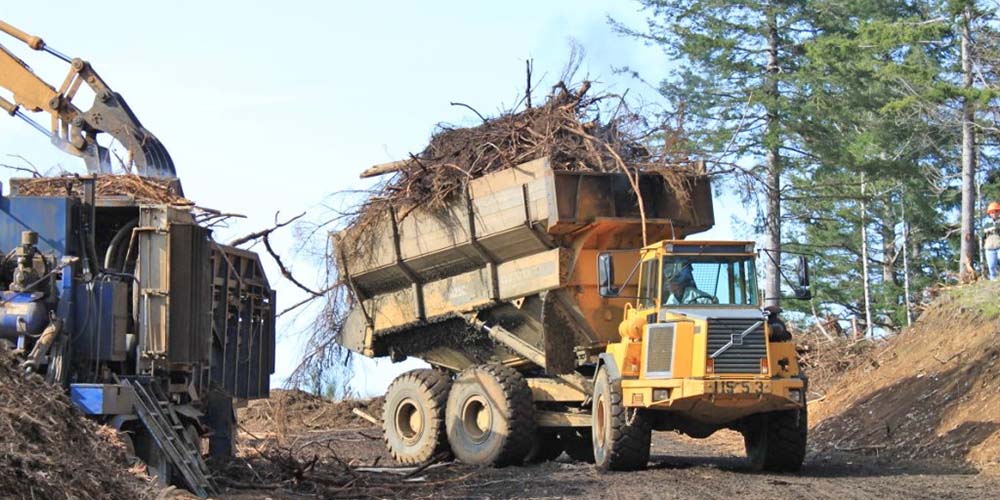
(Photo: U.S. Forest Service)
As California’s wildfire crisis has grown, it has become clear the state must focus not only on fighting fires, but on preventing them from igniting and spreading.
With that imperative in mind, the state is launching new initiatives aimed at a complex and critical problem: removing the excess and dangerous build-up of vegetation within forests and finding ways to put the woody materials to productive uses. The new efforts stretch across several state agencies and include a suite of interrelated strategies.
“This is not just a funding or loan exercise,” said Dan Adler, senior advisor for climate finance for the California Infrastructure and Economic Development Bank, known as IBank. “It’s about standing up an entire industry.”
Achieving the goal, Adler said, will require addressing complex challenges. That means not only addressing financing issues, but also developing a deep knowledge of the regulatory, workforce, and infrastructure hurdles facing the sector, and making sure government agencies at all levels are working in concert with one another and with regions to support the industry’s growth.
Spurring development of innovative wood products industries can reduce wildfire risks, promote forest and watershed health, and contribute to more climate resilient communities and economies, said Glenda Humiston, vice president of University of California Agriculture and Natural Resources and co-lead of the California Economic Summit’s Resilient Landscapes Work Group.
“We have so much at stake,” Humiston said. “Vibrant wood products industries are critical to the solution.”
Climate Catalyst Fund Roll-Out
Late last month, IBank began accepting project proposals through the new Climate Catalyst Fund. This revolving loan fund received $47 million through the state’s 2021-2022 budget. IBank is now poised to roll out those funds to jumpstart promising projects that will manage and process forest biomass material into productive uses, such as advanced energy products (including electricity and liquid and gaseous fuels), existing and emerging construction materials, and the supporting infrastructure and industries needed to make these products viable.
The Climate Catalyst Fund makes public funds available to help bridge financing gaps that are currently preventing technologies from scaling into the marketplace. The program builds on IBank’s history of financing public infrastructure and private development to advance a healthy climate for jobs, a strong economy, and improved quality of life for Californians and communities. IBank is located within the Governor’s Office of Business and Economic Development (GO-Biz).
“The program leverages public dollars to unlock private investment. It’s an accelerant,” Adler explained. When recipients repay the loans, the proceeds return to the fund for other projects that need gap financing. “In theory, it lives forever,” he said.
The initial focus of the Climate Catalyst Fund is on projects that can reduce wildfire threats and advance state climate goals through the management and use of forest biomass. During 2022-23, it is expected to also include climate-smart agriculture products.
OPR Feedstock Pilot Projects
A common problem for those trying to build new forest biomass production businesses is establishing reliable supplies of the woody material. Challenges range from lining up long-term contracts to transporting the heavy material in remote and rugged rural areas.
This month, the Governor’s Office of Planning and Research (OPR) is finalizing contracts with five regional groups to develop solutions to these feedstock supply hurdles. In all, $2.5 million will go to these groups, which include local governments and resource conservation districts. The funding was provided through an early action budget allocation for the 2020-2021 budget year.
The pilots are located in the Central Sierra, the Lake Tahoe Basin, the Shasta and Lassen County region, the North Coast, and Marin County. Participating groups will develop plans to improve woody feedstock supply chain logistics within each target region, and will assess market opportunities for potential biomass businesses in their regions.
Michael Maguire, associate planner for wood product Innovation at OPR, said the pilots are designed to develop regionally based solutions to the feedstock supply conundrum. The projects will address many types of land, public and private, including areas where fire resilience can be improved. The work does not include clear-cutting – only selective thinning where appropriate for landscape health.
Each pilot will employ an innovative governance structure such as a joint powers authority that will develop and implement plans to improve supply chain logistics and operate as feedstock brokers in each target region. These entities will serve as the link between feedstock harvesters and biomass industries by precuring biomass and offering long-term feedstock contracts.
CalFire Business and Workforce Development
To support forest sector workforce and business development, CalFire’s Wood Products and Bioenergy Team recently announced the availability of up to $24 million for wood products projects and up to $4 million for tree nursery operations. The purpose is to support healthy and resilient forests and the people and ecosystems that rely on these lands.
Projects receiving grant funding must demonstrate reduction of greenhouse gas emissions, economic strengthening, and improved public health. The goal of the granting program is to create incentives for industries to invest in clean technologies, develop wood products processing innovations, and support development of a strong forest sector workforce.
A Cross-Agency Strategy
According to Adler, these initiatives are part of a cross-agency strategy to advance new industries and technologies to broaden and improve California’s forest management. In January 2021, the Governor’s Forest Management Task Force released California’s Wildfire and Forest Resilience Plan, which included measures to promote a sustainable wood products market in California and is now being implemented.
These efforts are aligned with ongoing work of the California Economic Summit, which issued the report, California’s Wildfire Crisis: A Call to Action in 2019 urging the state to scale up preventive forest resilience activities and treat at least one million acres per year to reduce wildfire risks and build climate resiliency. Since then, the Summit has continued to advocate for solutions to the crisis. These themes will be an ongoing area of focus during the 2022 California Economic Summit in Bakersfield on October 27-28.

